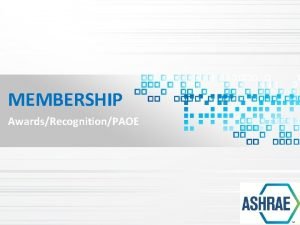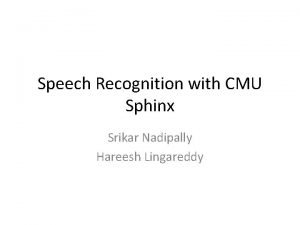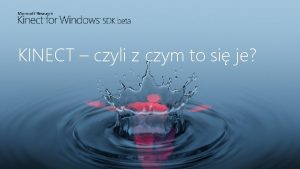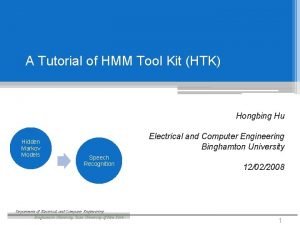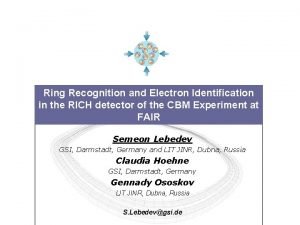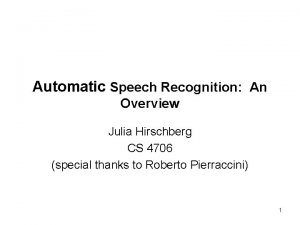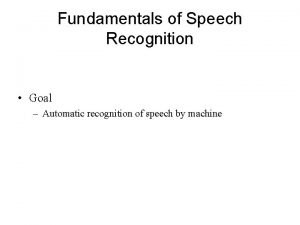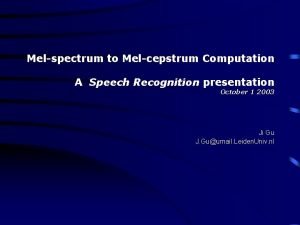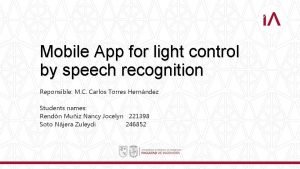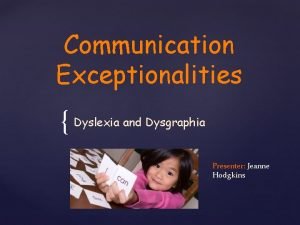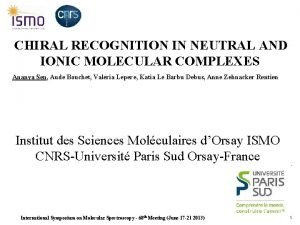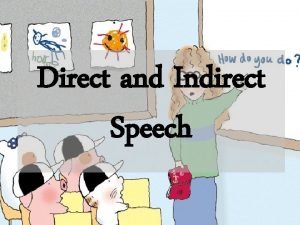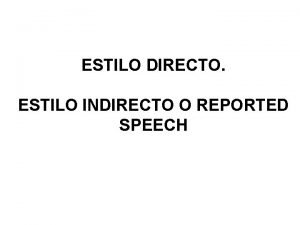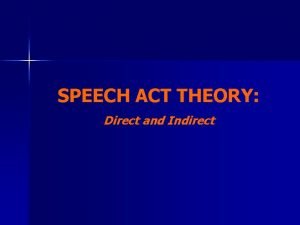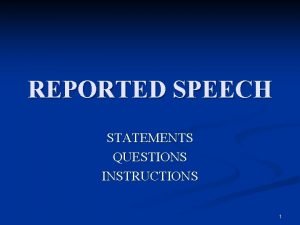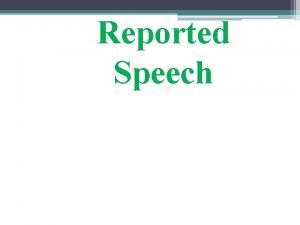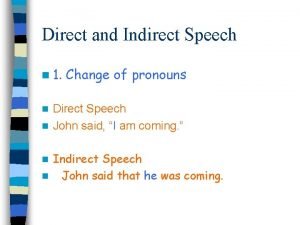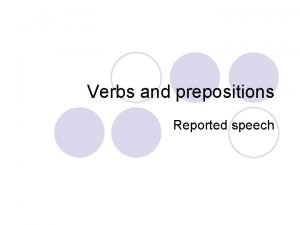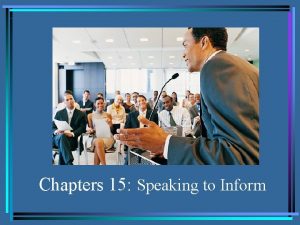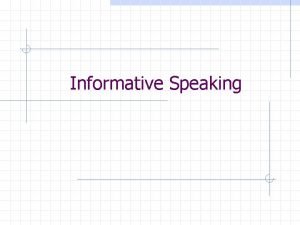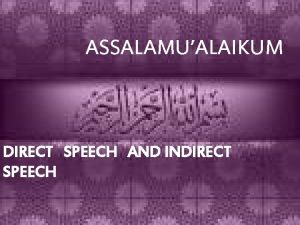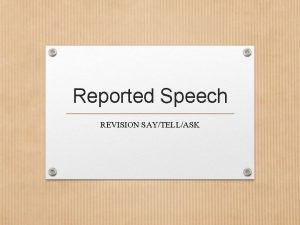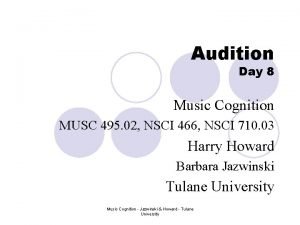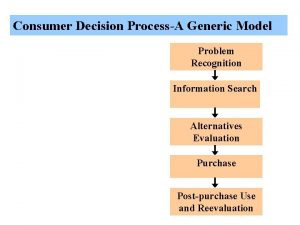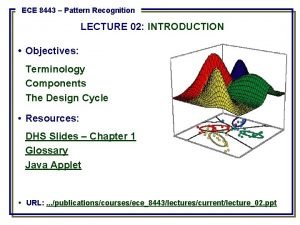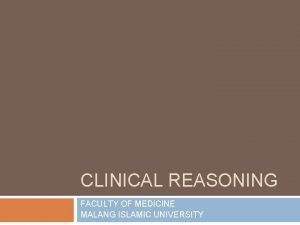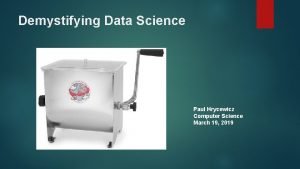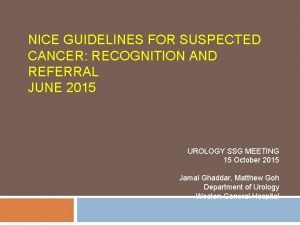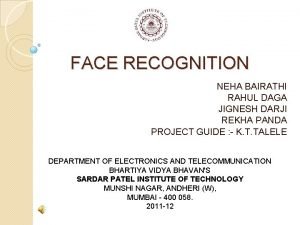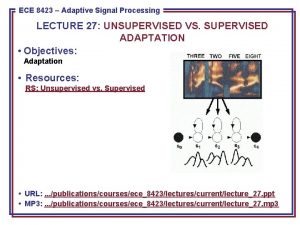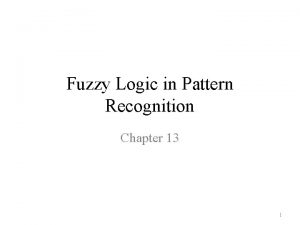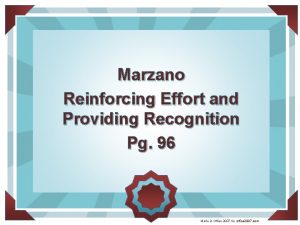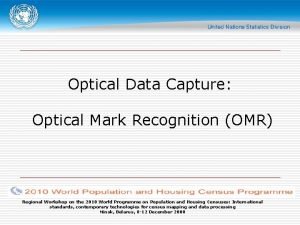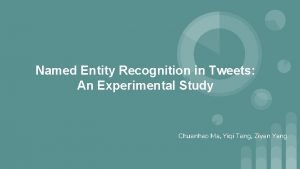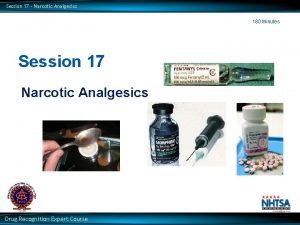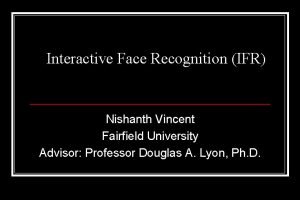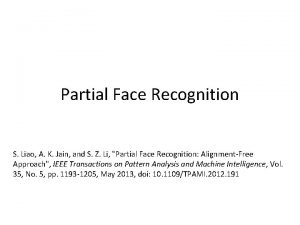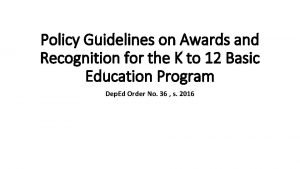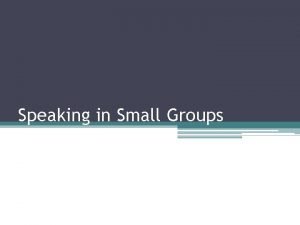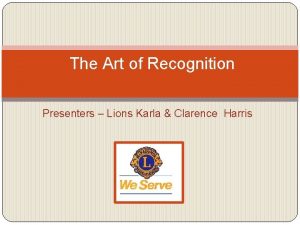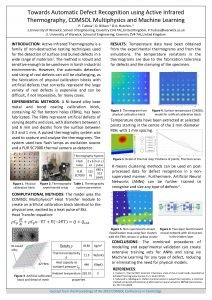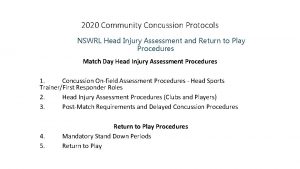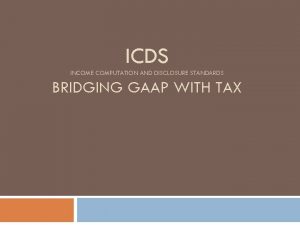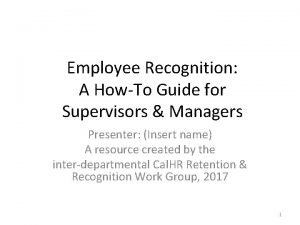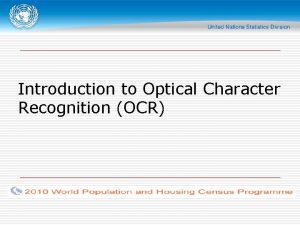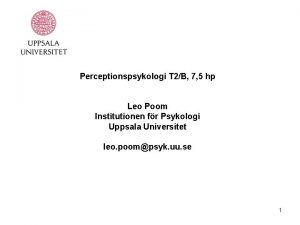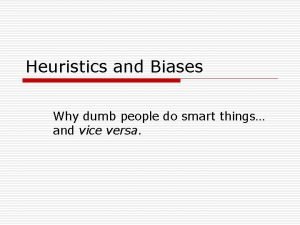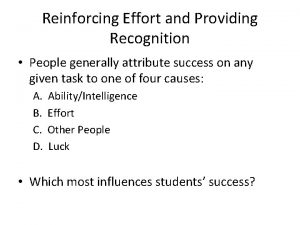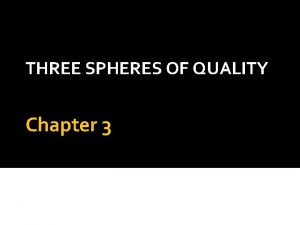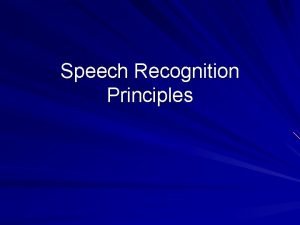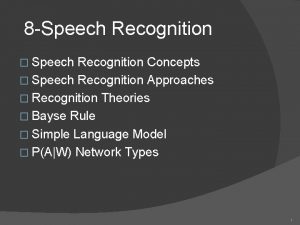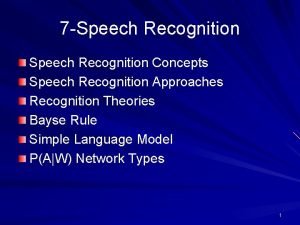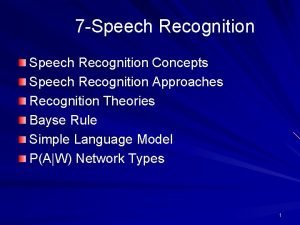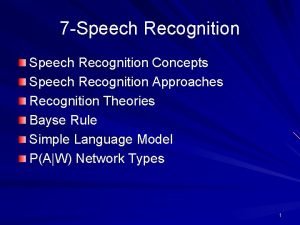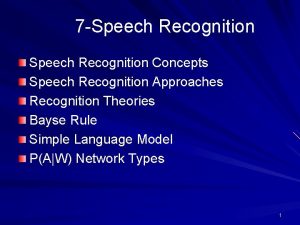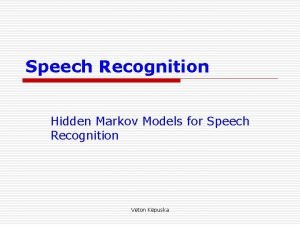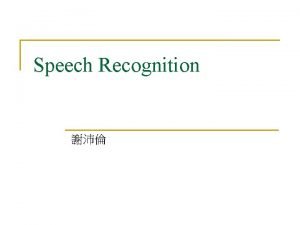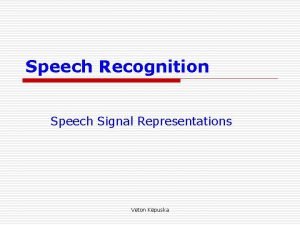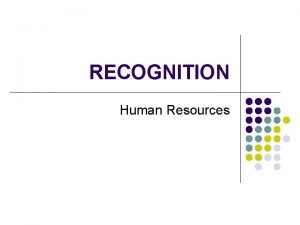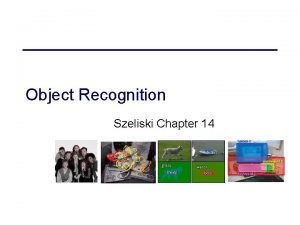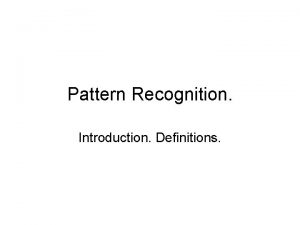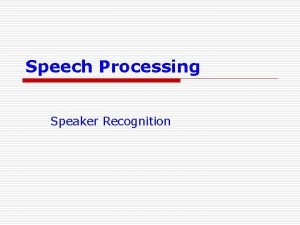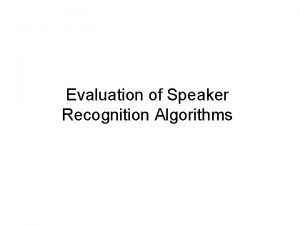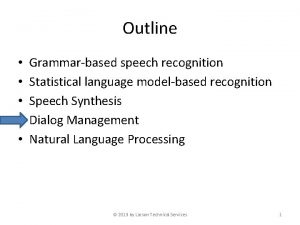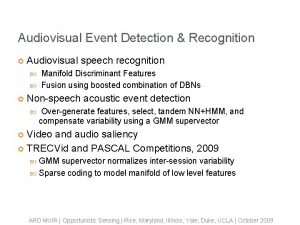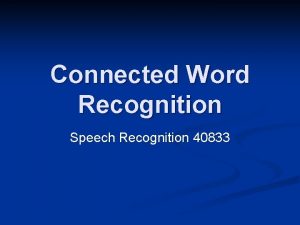8 Speech Recognition Speech Recognition Concepts Speech Recognition










































































- Slides: 74

8 -Speech Recognition � Speech Recognition Concepts � Speech Recognition Approaches � Recognition Theories � Bayse Rule � Simple Language Model � P(A|W) Network Types 1

7 -Speech Recognition (Cont’d) � HMM Calculating Approaches � Neural Components � Three Basic HMM Problems � Viterbi Algorithm � State Duration Modeling � Training In HMM 2

Recognition Tasks Isolated Word Recognition (IWR) Connected Word (CW) , And Continuous Speech Recognition (CSR) � Speaker Dependent, Multiple Speaker, And Speaker Independent � Vocabulary Size � �Small <20 �Medium >100 , <1000 �Large >1000, <10000 �Very Large >10000 3

Speech Recognition Concepts Speech recognition is inverse of Speech Synthesis Text Speech Phone Processing Sequence NLP Speech Processing Text Speech Understanding Speech Recognition 4

Speech Recognition Approaches � Bottom-Up Approach � Top-Down Approach � Blackboard Approach 5

Bottom-Up Approach Signal Processing Knowledge Sources Feature Extraction Voiced/Unvoiced/Silence Segmentation Signal Processing Sound Classification Rules Feature Extraction Phonotactic Rules Segmentation Lexical Access Language Model Segmentation Recognized Utterance 6

Top-Down Approach Inventory Word of speech Dictionary Grammar recognition units Feature Analysis Syntactic Hypo thesis Unit Matching System Lexical Hypo thesis Utterance Verifier/ Matcher Recognized Utterance Task Model Semantic Hypo thesis 7

Blackboard Approach Acoustic Processes Environmental Processes Lexical Processes Black board Semantic Processes Syntactic Processes 8

Recognition Theories Articulatory Based Recognition �Use Articulatory system modeling for recognition �This theory is the most successful so far � Auditory Based Recognition �Use Auditory system for recognition � Hybrid Based Recognition �Is a combination of the above theories � Motor Theory �Model the intended gesture of speaker � 9

Recognition Problem � We have the sequence of acoustic symbols and we want to find the words uttered by speaker � Solution : Find the most probable word sequence given Acoustic symbols 10

Recognition Problem �A : Acoustic Symbols � W : Word Sequence � we should find so that 11

Bayse Rule 12

Bayse Rule (Cont’d) 13

Simple Language Model Computing this probability is very difficult and we need a very big database. So we use Trigram and Bigram models. 14

Simple Language Model (Cont’d) Trigram : Bigram : Monogram : 15

Simple Language Model (Cont’d) Computing Method : Number of happening W 3 after W 1 W 2 Total number of happening W 1 W 2 Ad hoc Method : 16

Error Production Factor � Prosody (Recognition should be Prosody Independent) � Noise (Noise should be prevented) � Spontaneous Speech 17

P(A|W) Computing Approaches � Dynamic � Hidden Markov Model (HMM) � Artificial � Hybrid Time Warping (DTW) Neural Network (ANN) Systems 18

Dynamic Time Warping 19

Dynamic Time Warping 20

Dynamic Time Warping 21

Dynamic Time Warping 22

Dynamic Time Warping Search Limitation : - First & End Interval - Global Limitation - Local Limitation 23

Dynamic Time Warping Global Limitation : 24

Dynamic Time Warping Local Limitation : 25

Artificial Neural Network . . . Simple Computation Element of a Neural Network 26

Artificial Neural Network (Cont’d) � Neural Network Types �Perceptron �Time Delay Neural Network Computational Element (TDNN) 27

Artificial Neural Network (Cont’d) Single Layer Perceptron. . . 28

Artificial Neural Network (Cont’d) Three Layer Perceptron. . . 29

2. 5. 4. 2 Neural Network Topologies 30

TDNN 31

2. 5. 4. 6 Neural Network Structures for Speech Recognition 32

es for Speech Recognition 33

Hybrid Methods Hybrid Neural Network and Matched Filter For Recognition Acoustic Output Units Speech Features Delays � PATTERN CLASSIFIER 34

Neural Network Properties � The system is simple, But too much iteration is needed for training � Doesn’t determine a specific structure � Regardless of simplicity, the results are good � Training size is large, so training should be offline 35

Pre-processing � Different preprocessing techniques are employed as the front end for speech recognition systems � The choice of preprocessing method is based on the task, the noise level, the modeling tool, etc. 36

37

38

39

40

41

42






کپﺴﺘﺮﻭﻡ - ﺭﻭﺵ ﻣﻞ ﺳﻴگﻨﺎﻝ ﺯﻣﺎﻧی ﻓﺮیﻢ ﺑﻨﺪی |FFT|2 Mel-scaling Logarithm IDCT Cepstra Delta & Delta Cepstra Differentiator 48 Low-order coefficients



Time-Frequency analysis � Short-term Fourier Transform � Standard way of frequency analysis: decompose the incoming signal into the constituent frequency components. � W(n): windowing function � N: frame length � p: step size 51

Critical band integration � Related to masking phenomenon: the threshold of a sinusoid is elevated when its frequency is close to the center frequency of a narrow-band noise � Frequency components within a critical band are not resolved. Auditory system interprets the signals within a critical band as a whole 52

Bark scale 53

Feature orthogonalization � Spectral values in adjacent frequency channels are highly correlated � The correlation results in a Gaussian model with lots of parameters: have to estimate all the elements of the covariance matrix � Decorrelation is useful to improve the parameter estimation. 54

Cepstrum � Computed as the inverse Fourier transform of the log magnitude of the Fourier transform of the signal The log magnitude is real and symmetric -> the transform is equivalent to the Discrete Cosine Transform. � Approximately decorrelated � 55

Principal Component Analysis Find an orthogonal basis such that the reconstruction error over the training set is minimized � This turns out to be equivalent to diagonalize the sample autocovariance matrix � Complete decorrelation � Computes the principal dimensions of variability, but not necessarily provide the optimal discrimination among classes � 56

Principal Component Analysis (PCA) � Mathematical procedure that transforms a number of (possibly) correlated variables into a (smaller) number of uncorrelated variables called principal components (PC) � Find an orthogonal basis such that the reconstruction error over the training set is minimized � This turns out to be equivalent to diagonalize the sample autocovariance matrix � Complete decorrelation � Computes the principal dimensions of variability, but not necessarily provide the optimal discrimination among classes 57

PCA (Cont. ) � Algorithm Input= Covariance matrix (N-dim vectors) Output = (R- dim vectors) Eigen values Eigen vectors Transform matrix Apply Transform 58

PCA (Cont. ) � PCA in speech recognition systems 59

Linear discriminant Analysis � Find an orthogonal basis such that the ratio of the between-class variance and within-class variance is maximized � This also turns to be a general eigenvalueeigenvector problem � Complete decorrelation � Provide the optimal linear separability under quite restrict assumption 60

PCA vs. LDA 61

Spectral smoothing � Formant information is crucial for recognition � Enhance and preserve the formant information: �Truncating the number of cepstral coefficients �Linear prediction: peak-hugging property 62

Temporal processing � To capture the temporal features of the spectral envelop; to provide the robustness: �Delta Feature: first and second order differences; regression �Cepstral Mean Subtraction: ○ For normalizing for channel effects and adjusting for spectral slope 63

RASTA (Rel. Ative Spec. Tral Analysis) �Filtering of the temporal trajectories of some function of each of the spectral values; to provide more reliable spectral features �This is usually a bandpass filter, maintaining the linguistically important spectral envelop modulation (1 -16 Hz) 64

65

RASTA-PLP 66

67

68

Language Models for LVCSR Word Pair Model: Specify which word pairs are valid 69

Statistical Language Modeling 70

Perplexity of the Language Model Entropy of the Source: Assuming independence: First order entropy of the source: If the source is ergodic, meaning its statistical properties can be completely characterized in a sufficiently long sequence that the source puts out, 71

We often compute H based on a finite but sufficiently large Q: H is the degree of difficulty that the recognizer encounters, on average, When it is to determine a word from the same source. Using language model, if the N-gram language model PN(W) is used, An estimate of H is: In general: Perplexity is defined as: 72


Overall recognition system based on subword units 74
 Awards recognition concepts
Awards recognition concepts Occupational recognition award
Occupational recognition award Awards recognition concepts
Awards recognition concepts Cmu speech recognition
Cmu speech recognition Kinect for windows speech recognition language pack
Kinect for windows speech recognition language pack Htk tutorial
Htk tutorial Electron speech to text
Electron speech to text Julia speech recognition
Julia speech recognition Speech recognition
Speech recognition Fundamentals of speech recognition
Fundamentals of speech recognition Melspectrum
Melspectrum Speech recognition app inventor
Speech recognition app inventor Deep learning speech recognition
Deep learning speech recognition How dyslexic see words
How dyslexic see words Dragon speech recognition
Dragon speech recognition Aude leperre
Aude leperre Narration rules chart
Narration rules chart Direct speech into reported speech
Direct speech into reported speech What is indirect speech with examples
What is indirect speech with examples Cambios de pronombres en el reported speech
Cambios de pronombres en el reported speech Sentence types of sentence
Sentence types of sentence Reported and quoted speech
Reported and quoted speech They are playing football
They are playing football Direct and indirect speech wh questions exercises
Direct and indirect speech wh questions exercises Match the adverbs in direct speech and reported speech
Match the adverbs in direct speech and reported speech Present simple
Present simple Persuasive vs informative speech
Persuasive vs informative speech Informative speech vs persuasive
Informative speech vs persuasive Direct speech grade 3
Direct speech grade 3 Transform direct speech to indirect speech
Transform direct speech to indirect speech Pure speech
Pure speech Reported speech exercises doc
Reported speech exercises doc Ask reported speech
Ask reported speech Indirect speech simple past
Indirect speech simple past Quoted speech
Quoted speech Speech to the progress toward
Speech to the progress toward Gwendolyn brooks speech to the young analysis
Gwendolyn brooks speech to the young analysis Music recognition
Music recognition Selective problem recognition
Selective problem recognition Indirect methods of contoring uses how many methods
Indirect methods of contoring uses how many methods Objectives of pattern recognition
Objectives of pattern recognition Pattern recognition clinical reasoning
Pattern recognition clinical reasoning Paul hrycewicz
Paul hrycewicz Fingerprint recognition using matlab project
Fingerprint recognition using matlab project Reinforcing effort and providing recognition
Reinforcing effort and providing recognition Suspected cancer recognition and referral
Suspected cancer recognition and referral Face recognition
Face recognition Pattern recognition
Pattern recognition Instumental values
Instumental values Language
Language Fuzzy logic in pattern recognition
Fuzzy logic in pattern recognition Reinforcing effort and providing recognition
Reinforcing effort and providing recognition Omr mark engine
Omr mark engine Capitalized
Capitalized Drug recognition expert chart
Drug recognition expert chart Face recognition
Face recognition Face recognition
Face recognition Do no. 36, s. 2016
Do no. 36, s. 2016 Deserter dominator recognition seeker
Deserter dominator recognition seeker Lions are motivated by recognition
Lions are motivated by recognition Celebrating performance accenture
Celebrating performance accenture Flash thermography
Flash thermography Nrl head injury recognition and referral form
Nrl head injury recognition and referral form Icds on revenue recognition
Icds on revenue recognition Employee recognition toolkit
Employee recognition toolkit Clova face recognition
Clova face recognition Donor recognition levels
Donor recognition levels Optical mark recognition advantages and disadvantages
Optical mark recognition advantages and disadvantages Leo poom
Leo poom Pattern recognition
Pattern recognition Oo heuristics
Oo heuristics Reinforcing effort and providing recognition
Reinforcing effort and providing recognition Three spheres of software
Three spheres of software Pattern recognition lab
Pattern recognition lab Person recognition
Person recognition
